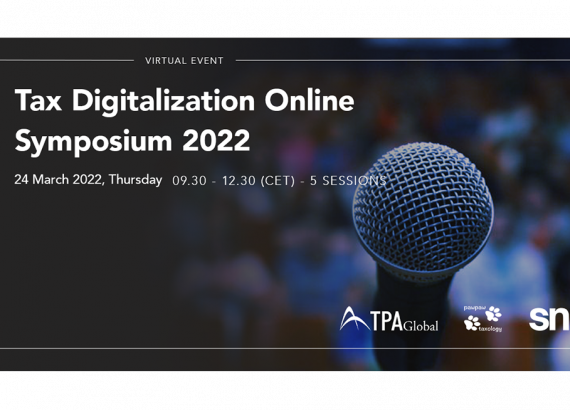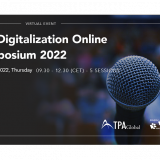Laurent Poigt – Tax Technology & indirect Tax Partner | PWC France

1- How long have you been working in taxation?
I started my career at Mazars & Associés and FIDAL/KPMG. I have been working as an Indirect Tax Lawyer for almost 18 years.
I joined PwC in 2011. I am a Partner on the Indirect Tax team, in charge of the “Technology, Digital and Transformation” activities.
2- What do you like so much about taxation and VAT specifically?
My Master’s studies in corporate finance and taxation opened up a whole range of possibilities for me. In particular, my first courses in VAT immediately interested me.
VAT occupies a central place in the taxation of companies and governments.
It is at the heart of the economy and corporate transactions.
Working in VAT gives the impression of fully participating in the business decisions of companies and clients at any level, whatever the domestic or international project.
3- When did you get interested in tax technology?
Very quickly, in the early years of my career.
Like any professional, I obviously started my apprenticeship in all the technical aspects of domestic and international VAT.
However, I soon realized that our advice and consultations could and should be enriched by broader skills, linked to knowledge of our clients’ businesses, of course, but also and above all to mastering their functioning and organization as economic players and operational entities.
The practical implementation of the technical VAT rules laid down by administrative doctrine or national or community case law must be reflected within companies’ organization and through an increasingly complex organizational ecosystem: multiple business and accounting application environments, different P2P/purchasing, sales/O2C and tax/VAT management procedures, numerous departments and users at the heart of decisions and responsibilities (finance, accounting, taxation, IT, purchasing/procurement, legal, sales/sales administration, internal control, logistics, management control, etc.), presence of third-party players (dematerialization platforms, subcontracting, Third Party Application Maintenance, etc.).
VAT is the transactional tax par excellence present at all levels of activity and organization.
Therefore, to provide the best possible support to companies and interact with all players without any particular obstacles, I wanted to develop new skills in technology, system configuration, dematerialization of invoices and processes, internal control and governance, data transformation and analysis.
This expertise and feedback not only help me to better understand the needs and operational constraints of companies, but above all to anticipate them.
4- Why is technology important for VAT?
As I have just indicated, VAT, system and operations are one and the same.
VAT must be appreciated as a whole within companies and leaves its mark everywhere. Of course, each operational or accounting tool – proprietary or not – must convey management rules and VAT settings in line with regulations.
This presupposes that tax professionals such as ourselves have sound knowledge of how ERPs work (SAP, Oracle – People Soft/JDE/E-Business Suite, Microsoft AX/NAV, Movex/M3, Sage, Cegid, other specifics, etc.).
Organizations also have other tools at their disposal to manage their performance or transformation, such as OCR solutions (often including VAT calculation rules), platforms for digitizing/electronic invoices or expense reports, Process Control Governance (GRC) solutions, databases, tools for managing tax/VAT compliance obligations, opportunity management and risk mapping, and electronic document management or archiving solutions (EDM, SAE).
Mastering the technology allows us to better manage and understand VAT.
Technology is a key component in business management.
Its mastery enables understanding of VAT and flow management in a relevant way. We act as intermediaries between the accounting and financial departments and other players in the company, which is what differentiates us in our relations with clients and our interventions.
The tax authorities have understood the importance of technology. For several years now they have been committed to policies to modernize companies’ more or less automated control of management, accounting and invoicing data.
The advent in recent years of more or less real-time clearance or reporting models in most European and international countries proves this reality.
To combat VAT fraud and reduce the VAT gap, the regulator is equipping itself with innovative and disruptive technologies to provide greater security, transparency and automation.
The “post-audit” models, which left no leeway for administrations in the event of a tax audit and which are currently used in some countries such as France, are beginning to disappear.
5- What is the most important challenge in the area of VAT and/or tax technology?
In my opinion, the most important challenge in terms of VAT management for businesses is to find a “fair and virtuous” balance between:
- (i) “security,” “compliance,” “control” and “transparency” taking into account existing or future regulatory issues (Quick Fix VAT reforms, E-Commerce Package, VAT Group / RTI Reporting or Clearance models, etc.), often driven by a desire to fight tax / VAT fraud,
and
- (ii) “performance,” “immediacy,” “simplification,” “digitalization” and “automation,” which are the necessary challenges of transformation projects for operational, financial and IT departments, taking into account organizations’ and IT models’ increasing complexity.
6- What is the most important non-compliance issue for VAT in France?
There is so much, it is hard to say to be honest. The concept and sensitivity to VAT “non-compliance” points can differ from group to group.
We can cite VAT fraud of course (even if companies do not like to talk about it), mismanagement of VAT rates, tax event rules, late or incorrect filing of VAT compliance obligations, the absence of VAT configuration, non-justification of international transactions, absence of VAT collection, absence of convincing invoices, erroneous VAT deductions, omitted reverse charges, and many others.
The subject of “non-compliance” varies according to the risk culture of economic decision-makers within companies. This culture may depend, in particular, on their experiences with controls (good or bad), the business model in place, the sector of activity and sometimes even the profile of group companies that can imprint compliance-oriented governance on companies (e.g., SOX policies).
For some, if implementation of VAT risk audit of their flows is fundamental and participates in the good management of a company (must have), for others only the tax compliance / VAT declarative or similar obligations are the priority (compliant and timely filing of VAT returns, Intrastat, EC Sales Lists, SAF-T, RTI Reporting, RTI Clearance, etc.).
This is the principle of “Nice to Have” vs. “Must Have.”
Also, in France, for example, the process of “relationship of trust” which can be put in place between the tax authorities and companies which wish to do so facilitates this awareness. Indeed, this relationship of trust implies that companies commit to disclosing their activities and tax / VAT positions and comply with accounting and VAT compliance obligations (notably through the implementation of the VAT “Reliable audit trail” documentation or the “Electronic Accounting File” – FEC).
A VAT Associate with whom I started said with humor to reassure customers when the difficulties arose, “Don’t worry, at the end of the day, VAT is neutral.”
If this adage is, in a way, the very essence of the economic system of VAT, for many entrepreneurs, this is unfortunately still true. VAT does not yet represent a risk for companies.
The strengthening of documentary, reporting and regulatory obligations in recent years, encouraged by a fierce desire on the part of the states to fight against VAT fraud, must lead companies to be extremely careful, especially as the challenges and risks to reputation have never been more important.
7- Would mandatory e-invoicing (like in Italy) or transactional e-reporting (like in Spain) improve VAT compliance and reduce VAT fraud?
Certainly. As previously indicated, the advent of Real Time Reporting or Clearance (CTC) models, making the administration appear as a new pivotal player in the ecosystem of purchase / sale transactions and compliance between business partners and itself, helps to fight fraud and improve compliance.
CTC models remedy the difficulties and inefficiencies of traditional models characterized by retroactive controls (“post-audit model”), where verifiers (general or IT) can only obtain visibility of a transaction long after its actual completion.
Real time (real or not) naturally corrects this discrepancy, brings immediacy and encourages companies to act on the control and quality of their data and transactions.
The ICC published an interesting report on these subjects last June. Also, the first returns to Italy on the checks carried out by the SdI show that the number of VAT payments has increased and that VAT credits are much more controlled or even rejected.
With the CTC models, the “static” approach is subscribed in favor of a “dynamic” approach to control for administrations.
8- What is the key issue for business with mandatory e-invoice/e-reporting systems?
Organization, anticipation and prevention, team training, data quality, tax / VAT governance, culture of managing the anomaly are the many priorities companies and economic decision-makers must have to comply with these reporting obligations and billing successfully.
Once the technical, interoperability, and data transmission (reporting or billing) issues have been resolved with the administration or the control portal, new mandates for e-reporting or e-invoicing should encourage organizations to adopt a culture of regulatory watch and effective tax / VAT governance fully connected to companies’ general internal control procedures and policies.
9- And what could France learn from the systems implemented in Italy, Spain or Poland?
As you know, Article 153 of the 2020 Finance Bill adopted an obligation for electronic invoices for companies from 2023 (landing in 2025 for all companies) with a desire to enrich the target model by exploiting data transmitted in order to pre-complete the turnover declarations (VAT return/CA3).
A report is to be submitted by the DGFIP to the French Parliament in September 2020 on the envisaged target model.
A plan for testing with pilot voluntary companies, implemented by the AIFE in charge of the Chorus Pro platform (currently applicable to B2G electronic invoicing obligations) has also been launched to anticipate this new reform.
The DGFIP, in its study to be submitted in September 2020, is aiming to survey all the players in the ecosystem in France (companies of all sizes, consulting firms including Bigs, specialized third parties, professional organizations and federations, etc.) and to identify the main issues that need to be addressed, but also to draw inspiration from foreign models, European or otherwise, such as Italy, (Sistema di Interscambio (SdI) – RTI for B2B domestic transactions based on XML-e-signed invoices), Spain (Suministro Inmediato de Información – SII), Poland (Poland SAF-T / JPK liabilities, RTI e-invoicing project, WhiteList, Split Payment) or the countries in the LATAM zone (very advanced in the application of end-to-end clearance models).
France will therefore be able to rely on all of these models by weighing up their respective pros and cons, i.e. the level of control desired by the government platform (data completeness, consistency checks, data analysis, etc.), granularity of the information transmitted (invoice only or broader), the authorized invoice issue formats (single structured format as in Italy, for example, via standardized standards – EDIFACT, XML, UBL, European semantic standard EN16931, etc.), and the level of control required by the government platform (data completeness, consistency checks, data analysis, etc.), the granularity of the information transmitted (invoice only or broader), the authorized invoice issue formats (single structured format as in Italy, for example, via standardized standards – EDIFACT, XML, UBL, European semantic standard EN16931, etc.). – or possible multi-channel formats – EDI/, PDF, WebEDI, mixed or Factor-X, etc., allowing the maximum number of operators to be enrolled and limiting constraints), use of certified third-party operators (as in Greece), enforceability of data transmitted and validated in the event of a subsequent tax audit, responsibility for the data archived on the platform as regards its use over time, scope of invoicing obligations (which transactions? only domestic, international, VAT-charged, exempt transactions, B2B/B2C? or only B2B?, rejection management policy, etc.)
The objective for France will be to find a “virtuous” and “scalable” model to enlist all companies while not adding too many constraints to companies that are already heavily burdened with tax and compliance obligations as part of their business.
10- What would be your proposal/advice for tackling VAT fraud in France?
To be honest, most companies do not necessarily feel concerned by VAT fraud, which does not also mean that the subject of tax or financial fraud in general is not taken seriously by organizations (cyber fraud, theft of personal data and vigilance with the GDPR regulation, financial fraud (president fraud), etc.). It is the principle of “it only happens to others, but not to me.”
The regalian objective displayed by the international authorities to reduce the VAT gap does not always come down clearly to the level of the organizations, the users of the daily financial process, the accounting departments or the supply chain. This is certainly due to a lack of knowledge, training in VAT principles or the culture of tax/VAT governance.
Current and future regulatory obligations (VAT audit trail liabilities, e-VAT reporting and SAF-T, e-invoicing mandate, etc.) are nevertheless gradually closing this gap and the orientations or digital transformation projects of companies attest to this.
The desire to better manage and organize their tax functions and their associated VAT compliance obligations will be a key success factor for the future.
In my opinion, the best way to manage the risks of VAT fraud is to go beyond the limits of the VAT technique alone and apply the same management rules throughout the entire organization. VAT is everywhere.
Managing VAT implies a knowledge of application systems and tools and their configuration (weaknesses and advantages), constant training of those involved in the entire process chain and not just the finance or accounting departments, a mastery and knowledge of one’s partners (suppliers, customers, third parties), a follow-up of one’s compliance obligations, the integrity of tax/VAT decisions, the anticipation of controls, and above all a culture of anomaly management.
Clearly, given the complexity of organizations, application tools and activities, anomalies are part of business life. However, it is still necessary to be able to clearly identify them, keep a record of them and be able to take relevant, immediate and appropriate corrective measures in line with regulations and companies’ financial and commercial policies.
Vigilance, prevention, ethics and knowledge of one’s company must be priorities in the fight against fraud.
11- You have written about digitization and are an advocate of the digitization of tax authorities. Do you think this digitization within the tax authority could help in fighting fraud?
Tax administrations certainly need to modernize to combat fraud and make the best use of the data they wish to control.
This modernization obviously involves introduction of new tools and control platforms. In my view, it also involves a reorganization of the directorates and audit brigades responsible for audits.
Specific cells and departments have emerged in recent years using more data-mining and Artificial Intelligence (AI) solutions via control algorithms, making it possible to exploit both professional and personal data.
In practice, as far as France is concerned, even if we are still lagging far behind other countries in terms of modernization, the administration has had a data-mining unit dedicated to “fraud targeting and request enhancement” for several years now. Its work has mainly focused on detecting VAT fraud, particularly with regard to undue reimbursement of VAT credits. A law against fraud adopted in October 2018 completed these measures with the threefold objective of better detecting, apprehending and punishing fraud.
Nevertheless, the French Court of Auditors, in a report of December 2019, pointed out that the measures taken are still too soft, that there are weaknesses in the steering and organization of policies to combat tax/VAT fraud, with too much decentralized action preventing complex fraud from being tackled. This development nevertheless demonstrates the tax administration’s growing interest in the massive data coming from information systems, which it no longer hesitates to use to better target its tax audits.
Such practices represent a new challenge for businesses, which must now think about integrating the collection, management and use of data concerning them into their tax strategies, particularly with regard to VAT. It is partly thanks to its digital initiatives that the French Government has just announced an increase of 2 billion in additional tax revenue for 2019 as part of its tax audits (a total of around 12 billion for the year 2019), the highest level since 2015.
12- What are the most important disadvantages of the mandatory e-invoicing/e-reporting for companies?
I only see medium- / long-term benefits for companies to switch to e-invoicing and e-reporting obligations that will “free up the data.”
Obviously, significant financial gains can be expected in the long term in terms of invoice management and reporting obligations.
Advantages in terms of flexibility of information and data management are also to be expected. Finally, a more transparent and direct role with the administration will simplify the controller/controller relationship.
As regards the main disadvantages and short-term constraints to be anticipated, which entail significant financial costs and operational and fiscal/VAT uncertainties, they would relate in particular to:
- (i) Bringing into line with standards and adapting existing invoice dematerialization solutions or internal accounting and invoicing application tools,
- (ii) The risks of interoperability to ensure the exchange of electronic data,
- (iii) The periodicity of data transmissions (real time or not) which can be a hindrance for the actors,
- (iii) The use of reporting/invoicing formats imposed and not adapted to all companies,
- (iv) Failure to take into account operators’ business constraints, complex flows (intermediation/disbursements, deposits, domestic reverse charge, multiple rate management, asset management, returns, etc.),
- (v) Increased compliance obligations.
- (vi) The modification of the rules of tax control and administered / administration relations which may imply more insecurity,
- (vi) Management of rejection of data transmitted by the tax authorities.
Another side-effect of introducing its new models would be that the change required is often immediate and radical. Businesses often find themselves faced with a fait accompli and have not had time to think about how they would organize their e-invoicing flow with their trading partners.
13- Lastly, what do you have to say to the reader about Tax Technology (for example, regarding policy/implementation/priority, etc.)?
If you wish to follow and support your organizations or clients in the best possible way, as a tax and VAT expert, mastering technological, digital and transformation issues is vital.
The modernization of financial and tax policies in the coming years will accentuate this observation.
From clearance models to AI, including Robots (RPA), automatic tax management and determination tools and their control, the world is going digital.
Technology is at the heart of the challenges facing our professions and it is fundamental to control this movement.
However, it is certain that human beings will always have to be at the heart of business decisions and choices, to ensure that tax rules are properly applied.












